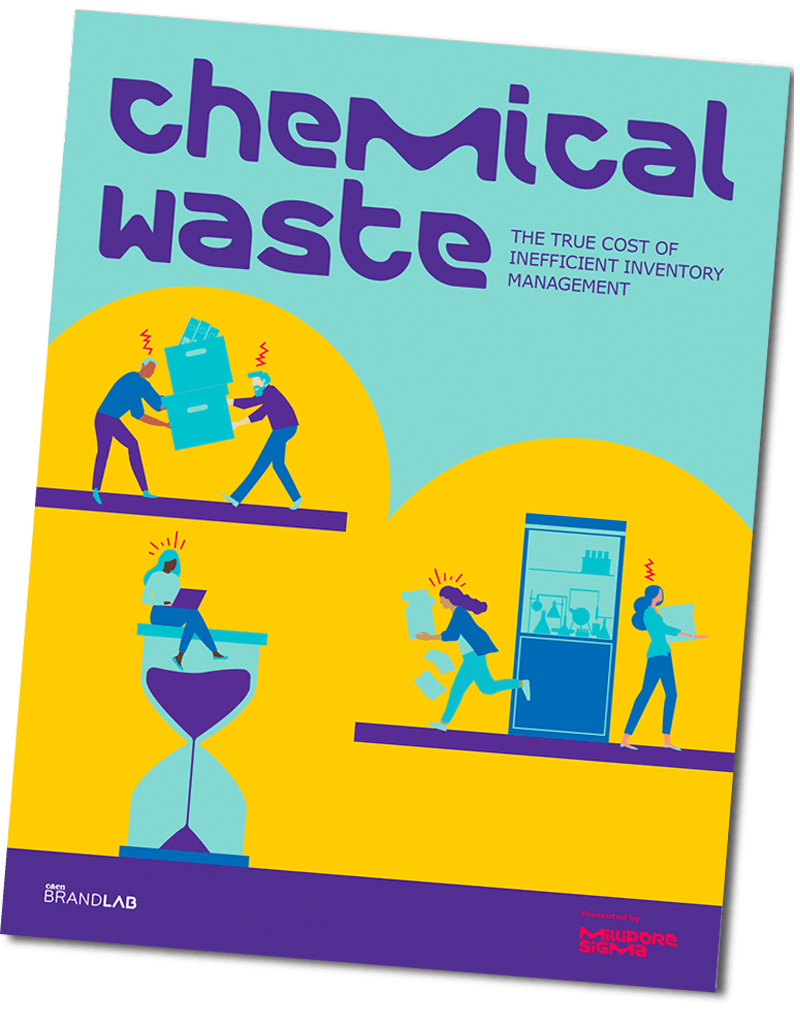TakingBy Michael EisensteinContributing Writer,
C&EN BrandLab
stock:
C&EN BrandLab
C&EN BrandLab
Y ou need a solvent for your experiment. But when you go to the chemical cabinet to retrieve it, there’s just an empty spot on the shelf. A quick review of the lab inventory spreadsheet tells you there should be a bottle in stock, but tracking it down may require some detective work—assuming the sheet is accurate in the first place. Perhaps you should go ahead and order a new bottle, just in case?
These sorts of stories play out often enough that many researchers just accept them as inevitable travails of laboratory work. But mismanaged chemical stocks can take a significant toll over time. “Most people don’t realize that inventory management is a problem,” says Roja Azees, product manager for lab management tools at MilliporeSigma. “No one has told them: what you’re doing right now will cost you time and money.”
Commercial labs use various methods to address difficulties with their chemical inventory, but many still rely on old-fashioned approaches based partly on pen-and-paper or homemade Excel spreadsheets. In a 2020 survey of 1,024 laboratory staff conducted by C&EN BrandLab and MilliporeSigma, fewer than half of respondents reported using purpose-built software for chemical inventory management, and of those only 37% described themselves as “satisfied” or “very satisfied” with their current solution.
While a suboptimal inventory management system can capture certain details a lab needs, it may not keep tabs on expiration dates or storage safety. Those omissions can cause headaches when a lab member goes to fetch one of those chemicals. And if the chemical inventory management system is too labor intensive to maintain, staffers may opt out of updating it, leaving the lab with a misleading representation of current stocks. Christian Kuechenthal, head of lab management tools at MilliporeSigma, says he once worked in a lab that struggled with a barcode-based system. “It worked fine for a few months, but then it lost traction,” he says. After a while, he adds, lab staffers weren’t able to guarantee what was and wasn’t there.
Fortunately, chemical inventory management tools are emerging that could overcome these problems. For example, MilliporeSigma’s LANEXO system employs labels for reagent containers with radio frequency identification-tagged “smart seals.” These tags can relay essential information about a chemical product: when it was received and opened and where it is being stored, which enables comprehensive inventory tracking with minimal user effort. The decision to overhaul a chemical inventory management strategy in a commercial research laboratory is not taken lightly. But the perils and hidden costs of an inadequate system may motivate some groups to begin this conversation.
Wasted hours
Labs are powered by the efforts of a highly educated and trained workforce. But many lab members end up devoting a considerable amount of their week to chasing down chemicals rather than doing scientific work. Most inventory systems require tedious manual data entry, and 54% of the respondents in the 2020 survey cited recording inventory as a major burden. In fact, 23% reported spending at least 10% of their work hours per month entering such data.
But failure to keep up with this task also leads to wasted time and effort. One survey respondent, a petrochemical industry scientist, said that “the most productivity-killing factor is time spent searching for chemicals.” A poorly maintained inventory system will leave researchers scrambling to track down reagents that may not even be in the laboratory, creating otherwise avoidable delays in carrying out their work. More than a quarter of survey respondents noted that they were unable to perform a scheduled experiment about 10% of the time as a direct result of missing reagents.
Money down the drain
When researchers fail to track down a needed reagent, they may opt to order a replacement rather than spend more time on the hunt. This can lead to excessive stockpiles of reagents that ultimately expire and thus go to waste. Alessandra Pepe, chemistry, manufacturing, and control technology and innovation lead at MilliporeSigma, encountered this issue when her group conducted an audit of its inventory practices. “We were wasting about 12% of our reagents, and that was mostly due to overstock,” she says.
In many cases, the needed reagents may be on-site but “invisible” due to the lack of centralized inventory resources that accurately log current stocks and locations. One survey respondent, a research chemist at a manufacturing company, cited problems with duplicate purchases “because we don’t realize what we have.”
When these reagents go bad, the tab can add up quickly. Fifteen percent of survey respondents reported losing at least 10% of their chemical stock to expiration. The median estimated cost of this waste and associated disposal was about $1,500 a month—but some respondents cited monthly losses of tens or hundreds of thousands of dollars.
Safety first
Every reagent comes with a safety data sheet containing essential information about proper storage. But this safety material is often stored separately from the inventory, so lab workers may inadvertently create dangerous work conditions by storing chemicals inappropriately. Thirty-nine percent of survey respondents felt that safe storage was among the most pressing issues in inventory management. One chemist at a food and beverage manufacturer reported finding “incompatible chemicals stored in proximity due to lack of space.”
Without an inventory system that accounts for safe storage, these problems can go unnoticed unless lab members are especially vigilant—or until a dangerous situation arises. Kuechenthal recalls a lab where a large bottle of highly reactive peroxide had been stored next to expired flammable solvents. “Just taking that bottle off the shelf could actually generate an emergency,” he says, adding that the lab had to close for a day so that safety personnel could remediate.
MilliporeSigma
Reassuring the regulators
All these issues become particularly critical for facilities that operate under the constraints of regulatory compliance. For example, good laboratory practice standards entail routine audits, which require lab heads to provide a comprehensive “paper trail” recording their reagents’ provenance and usage. “The job of collecting all this information is done by the end users,” Azees says. “They then share that information with the lab heads or quality heads or environmental health and safety managers.”
Such records are especially important in the event of a breakdown—if a manufacturing batch fails, for instance, and a faulty reagent is the likely culprit. The lab must systematically review all materials used in that procedure, and a detailed inventory is vital. “You have to make sure that you are not using expired chemicals,” Kuechenthal says, and that “you can track down the right batch number.”




